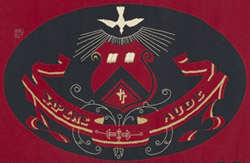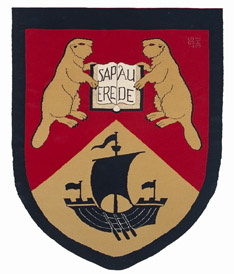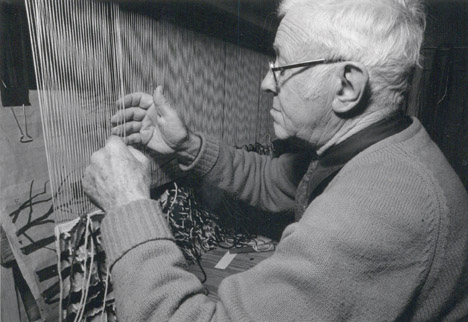These wool tapestries were woven by fibre artist and UNB alumnus Ivan H. Crowell (Class of '29) in the early 1980s. Each tapestry represents approximately 26 eight-hour days at the loom plus another seven days of handsewing and finishing. Dr. Crowell created the patterns for all the woven images represented here, and Susan Turnbull worked her embroidery needle on them. These four tapestries trace the university's corporate history.
The College of New Brunswick Seal (1800)
 The University of New Brunswick can trace its roots to 1785 when seven Loyalist refugees, led by William Paine, petitioned Governor thomas Carleton for the creation "of an Academy or School of Liberal Arts and Sciences."1
the Academy operated until 1800 when, by provincial charter, it became the College of New Brunswick.
The University of New Brunswick can trace its roots to 1785 when seven Loyalist refugees, led by William Paine, petitioned Governor thomas Carleton for the creation "of an Academy or School of Liberal Arts and Sciences."1
the Academy operated until 1800 when, by provincial charter, it became the College of New Brunswick.
Initially the College, like the Academy, functioned as a grammar school and offered courses in the liberal arts and sciences, as well as religion and morality.2 By the early 1820s students were receiving university-level instruction. The College of New Brunswick was succeeded by King's College, which was created by the granting of a royal charter on 15 December 1827.3
This tapestry incorporates the major features of the College of New Brunswick seal - a dove, a Latin cross, and an open book. The text on the left-hand page, partly obscured by the superimpsed cross, reads in Hebrew, "In the beginning God created the heavens and the eart ...and the Spirit of God moved upon the face of [the waters]." On the right-hand page the partly obscured Greek text reads, "THE GOSPEL ACCORDING TO SAINT JOHN," followed by the first six words of the first verse of John's gosepl, "In the beginning was the Word."4 A dove descending, with wings displayed hovers above. The Latin phrase around the edge is an abbreviation of Sigillum Collegii Novi Brunsvici (Seal of the College of New Brunswick). The College of New Brunswick seal continued in use during the King's College years.
The University of New Brunswick Seal (1864)
 In 1859, by an act of the provincial legislature, King's College was transformed into the University of New Brunswick, a truly secular provincial institution. A senate-appointed committee of two, Lemuel A. Wilmot and John S. Saunders, was directed to arrange for the fashioning of a new corporate seal. Approved in March 1864, the recast College seal became the official seal of the newly-chartered university.5
In 1859, by an act of the provincial legislature, King's College was transformed into the University of New Brunswick, a truly secular provincial institution. A senate-appointed committee of two, Lemuel A. Wilmot and John S. Saunders, was directed to arrange for the fashioning of a new corporate seal. Approved in March 1864, the recast College seal became the official seal of the newly-chartered university.5
Dr. Crowell patterned this tapestry after the seal on his graduation diploma. Placed inside an ellipse,the image features a shield divided by a chevron with two open books at the top and a Latin cross at the base. A dove descending, partially surrounded by rays of light, hovers above. The university's motto Sapere Aude (Dare to be Wise) appears on a scroll below the shield.
The University of New Brunswick Seal (1968)
 In the 1960s UNB president Colin B. Mackay, considering that the College of New Brunswick seal was one of the oldest university seals in Canada, recommended that it become the corporate seal of UNB. With senate approval and after a few modifications by well-known Czech-American graphic artist and engraver Rudolph Ruzicka, the College seal was returned to use. Today it appears on all official documents, including diplomas and legal instruments.6
In the 1960s UNB president Colin B. Mackay, considering that the College of New Brunswick seal was one of the oldest university seals in Canada, recommended that it become the corporate seal of UNB. With senate approval and after a few modifications by well-known Czech-American graphic artist and engraver Rudolph Ruzicka, the College seal was returned to use. Today it appears on all official documents, including diplomas and legal instruments.6
The seal of 1968 closely resembles the College seal of 1800, featuring the Latin cross, the dove, and hte open book with Hebrew and Greek text. To the 19th century design, Ruzicka added three clouds at the base, which Dr. Crowell incorporated into the woven image. Bordering the seal is the Latin abbreviation of Sigillum Universitatis Novi Brunsvici.
The University of New Brunswick Coat of Arms (1956)
 UNB's predecessor, King's College, did not receive an official coat of arms at the time of its creation in the 1820s, but instead adopted the royal coat of arms as its own. In 1953 Beverley Macaulay, the university's business manager, raised the matter of official arms for UNB. With senate approval, a committee was formed to select a design. On 14 March 1956 UNB was granted armorial bearings from the College of Heralds in London. The design was approved by senate in May of the same year.7
UNB's predecessor, King's College, did not receive an official coat of arms at the time of its creation in the 1820s, but instead adopted the royal coat of arms as its own. In 1953 Beverley Macaulay, the university's business manager, raised the matter of official arms for UNB. With senate approval, a committee was formed to select a design. On 14 March 1956 UNB was granted armorial bearings from the College of Heralds in London. The design was approved by senate in May of the same year.7
Dr. Crowell wove two variants of the UNB coat of arms, one with a rounded bottom edge and another with a straight bottom. The shield is divided by a chevron. At the top two beavers stand facing each other holding an open book inscribed with the university's motto Sapere Aude. At the base is an ancient galley with its oars in action, resembling the one on the provincial coat of arms. The open book symbolises learning; the galley, the province's shipping and shipbuilding heritage; and the beavers represent Lord Beaverbrook, a generous benefactor and former chancellor of the University of New Brunswick.
Ivan H. Crowell

Teacher, pewtersmith, master weaver - Ivan H. Crowell (1904-2003) distinguished himself in all his chosen careers. A native of Caledonia, Nova Scotia, he launched his first career in 1922 teaching manual training in Nova Scotia public schools. After three years he enrolled in the University of New Brunswick and earned a BSc in forestry before pursuing graduate studies at Miami and Harvard Universities.
Dr. Crowell taught botany for several years before his career path changed course. In 1940 he became director of handicrafts at McGill University. He held that post until 1946 when he moved to Fredericton to become director of handicrafts for New Brunswick. A key player in the local arts community, he established the New Brunswick Craft School and served as director for over 20 years.
Following retirement in 1969, Dr. Crowell studied pewtercraft in the United States and England, and then embarked on another career. Over the next five years he designed and created pewter objects and instructed dozens of artisans from across North America in the techniques of pwetersmithing. His skill and dedication won him recognition as a modern pioneer of the craft in Canada. In 1973 he was named a member of the Order of Canada for his services in fostering handicrafts throughout New Brunswick.
In the 1970s, Dr. Crowell was inspired by Nel Oudemans, an accomplished weaver, to develop his earlier love of another ancient craft, tapestry weaving. Since then he has woven over 250 tapestries depicting scenes of New Brunswick history, architecture, local legends, nursery rhymes, and airy tales. One of his last projects involved preserving child art by weaving a number of children's drawings as tapestries. Dr. Crowell's wool images decorate churches, hospitals, libraries, museums, schools, and universities in New Brunswick and elsewhere. He generously donated more than 90 tapestries to his alma mater, including the bicentennial series of UNB buildings, the student residence series, and the heraldic series represented here. Dr. Crowell died at Fredericton in May 2003.
Text by Janice Cook (December 2000); Tapestry photos by Annette Young
- 1Petition of William Paine et al to Governor Thomas Carleton, 1785
- 2Charter of the College of New Brunswick, 12 February 1800
- 3Montague, Susan. A Pictorial History of the University of New Brunswick (1992), pp. 15-17
- 4Explication of these texts courtesy of professor Michael J. Mills
- 5UNB Senate minutes, 26 June 1861, p. 70; 10 March 1864, p. 98
- 6Montague, pp. 190-191
- 7Montague, pp. 152-153
- Main Page
- Anniversaries
- Brief History of UNB
- Buildings
- Faculties and Departments
- Governance and Administrative Positions
- Lecture Series
- Official University Events and Symbols
- People of UNB
- Plaques, Monuments and Structures
- Prizes and Awards
- Sports and Athletics
- Student Clubs and Societies
- Student Events and Escapades
- University Publications
- Women's Sports at UNB
- About UNB Archives and Special Collections
Request an Appointment
Prior arrangements must be made for the retrieval of this material. Please email archives@unb.ca to make an appointment.
Procedures
Help Desk Hours
- Monday - Friday
- 10:00 am - 12:00 pm
- 1:00 pm - 4:00 pm
Contact Us
- 5th Floor, Harriet Irving Library
- University of New Brunswick
- 5 Macaulay Lane, Box 7500
- Fredericton, NB E3B 5H5 Canada
- archives@unb.ca
- Staff Directory